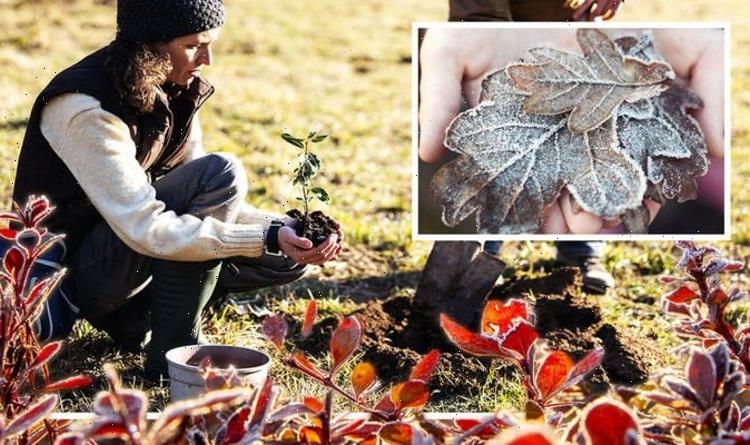BBC Weather: Carol Kirkwood warns frost is on the way
We use your sign-up to provide content in ways you’ve consented to and to improve our understanding of you. This may include adverts from us and 3rd parties based on our understanding. You can unsubscribe at any time. More info
As magical as the russet hues of autumn may look in British gardens, the crunchy sound of the ground beneath your feet is a good indication of the first frost. While the date of this crucial day in the gardening calendar will vary across the country, being prepared for the first frost is essential if you want your garden to thrive through winter. Express.co.uk spoke to the gardening experts to find out when you’re likely to expect the first frost.
When will the first frost arrive in the UK?
The first frost in the UK can be expected anytime from November depending on where in the UK you live.
Generally the further north, the earlier the frosts.
Garden landscaping expert, Tom Trouton, told Express.co.uk: “Climate change has created changes to the timings of the first frost – and as gardeners, we can never be sure of the seasons in quite the way we were only a few years ago.
“I would always say, expect a frost at any time during the autumnal months and be prepared.”


With frost times changing each year, forecasting a nationwide frost date is nearly impossible.
Tom added: “As a child growing up in Exmoor, we used to experience our first light frosts in September, and we always associated them with a glorious day ahead of sunshine.
“Now, they often arrive in early November, and we are still awaiting the first frost of the season.”
Last year, the first air frost in the UK was recorded as November 4, 2020.
The earliest ground frost in 2020 was September 28.

Can the weather forecast predict the first frost?
Checking the weather forecast in your area will certainly give you an idea of the rise and fall in temperatures, wind and humidity, but experts say it is not always reliable to reveal the first frost.
Liam Lapping of Flowercard told Express.co.uk: “The most common type of frost forms on a clear night when the temperature of the surface falls below 0C and there is enough moisture in the air.
“On nights averaging 0-4C, with little cloud and little wind, you are more likely to see frost.”
DON’T MISS:
‘Rates we’ve never known!’ Martin Roberts on why to buy a home now [INSIGHT]
Gardening: How often do you water an orchid? Expert’s guide [EXPERT]
‘Can’t beat it!’ Mrs Hinch fans share ‘amazing’ hack for grout [TIPS]

How does frost affect plants?
While many of our plants are incredibly resilient and hardy against extreme temperatures, other more tender plants such as Mediterranean plants and exotics like bananas and cannas will be susceptible to frost.
Kate Turner, Miracle-Gro’s Gardening Guru told Express.co.uk: “Damage occurs when the water in plant cells begins to freeze and expand – damaging the cell and rupturing the cell wall.”
Frost damage to plants can result in a limp, blackened and often brown or slightly translucent appearance.
Unfortunately, most tender plants with frost damage will die but follow these tips below to ensure your garden remains a frost damage-free zone:
- Insulate pots – wrap and cover with fleece or bubble wrap
- Bring pots indoors or raise them to avoid sitting water which can freeze
- Mulch exotic plants and cover with horticultural fleece
- Use straw to protect the central growing point (crown) of the plant
- Don’t feed plants in winter – new growth is susceptible to frost damage
Source: Read Full Article
